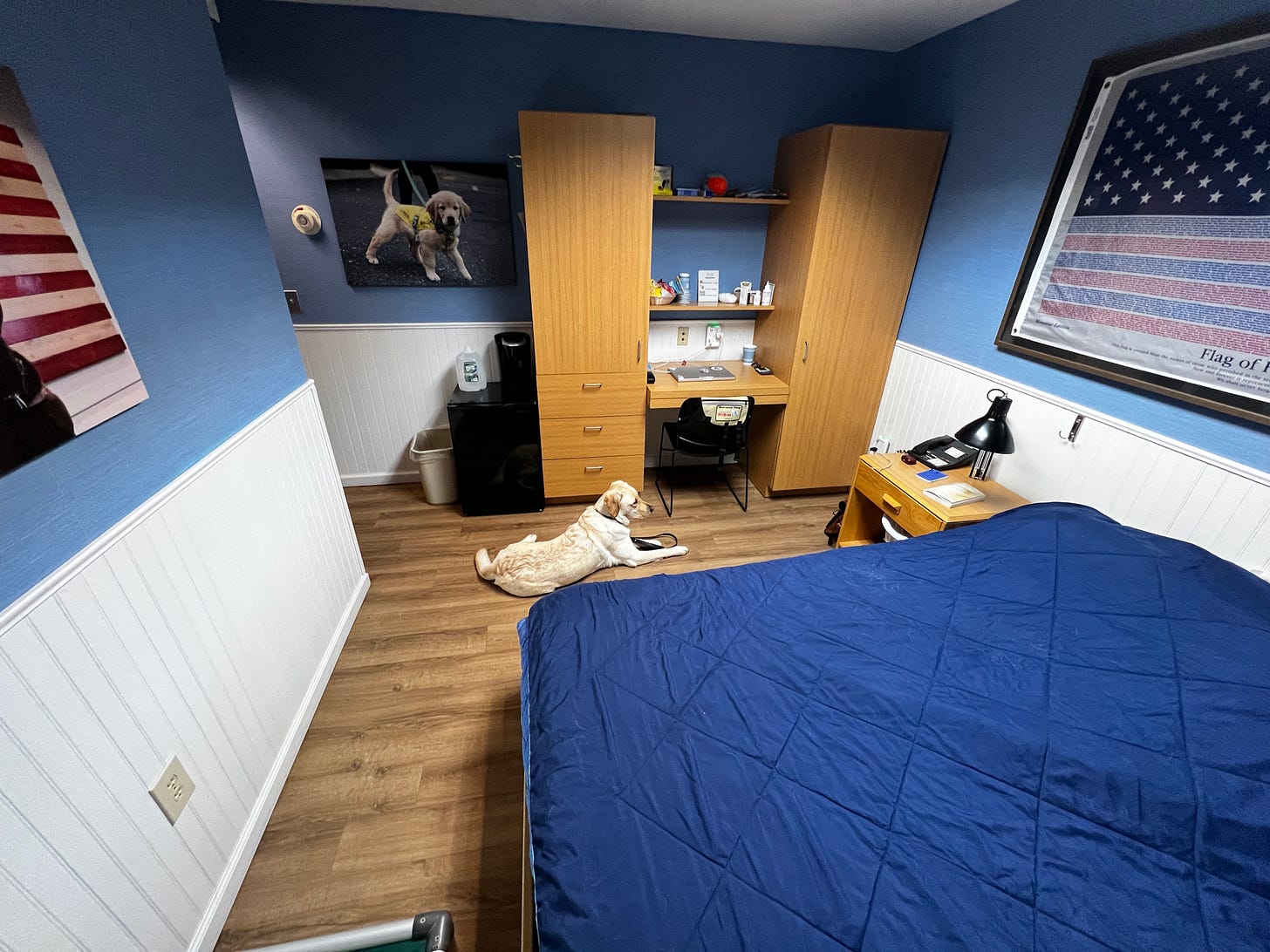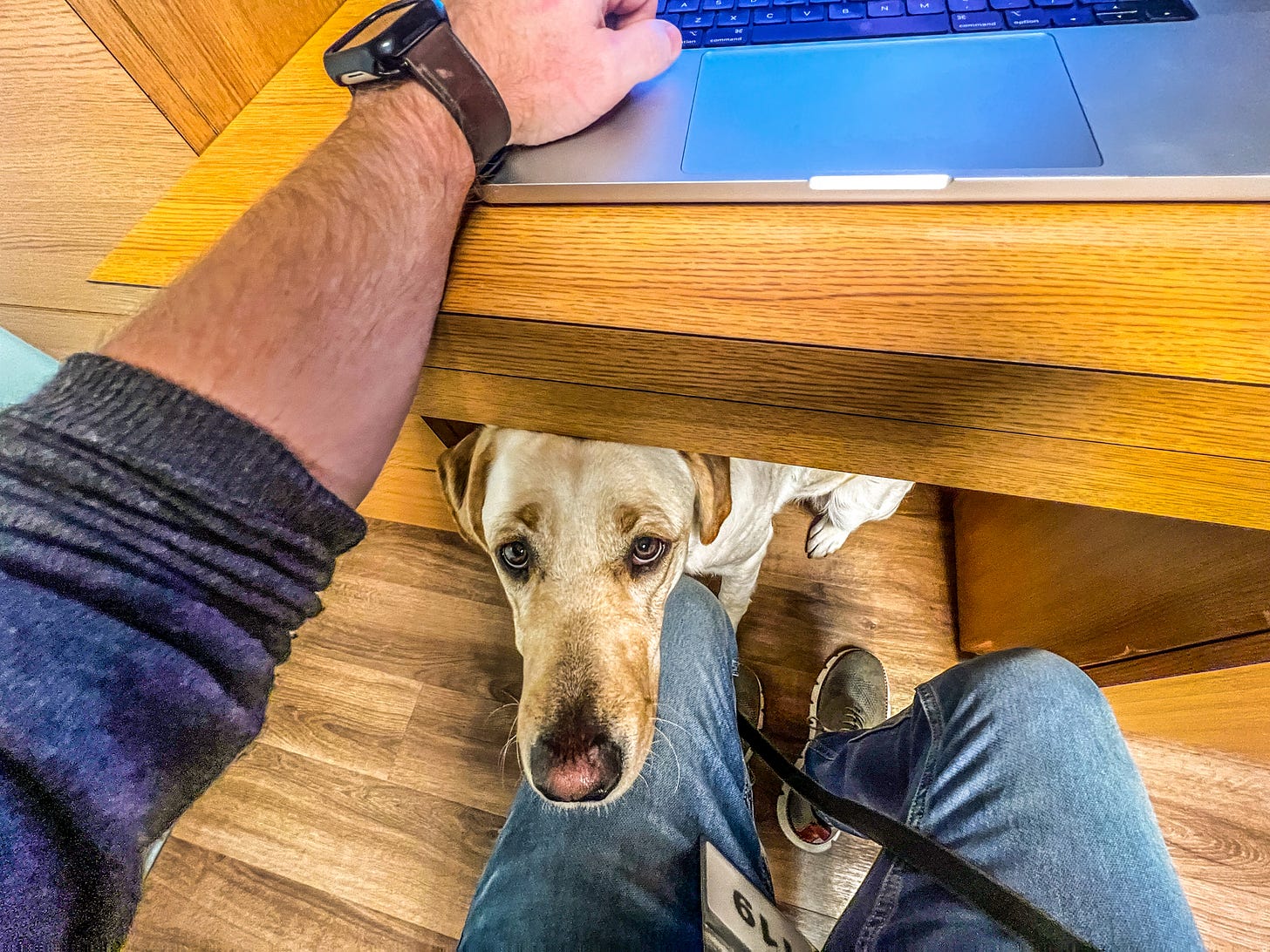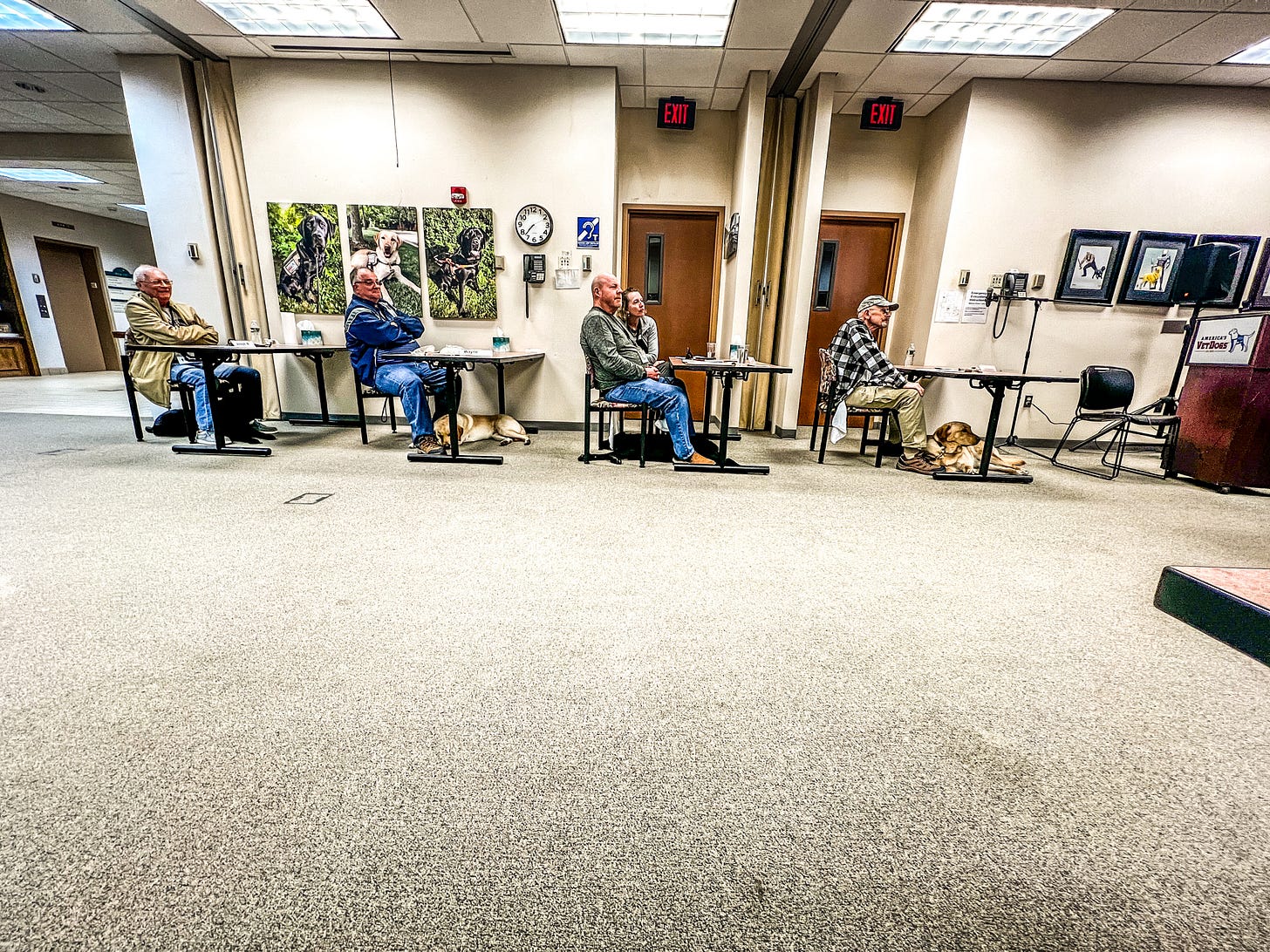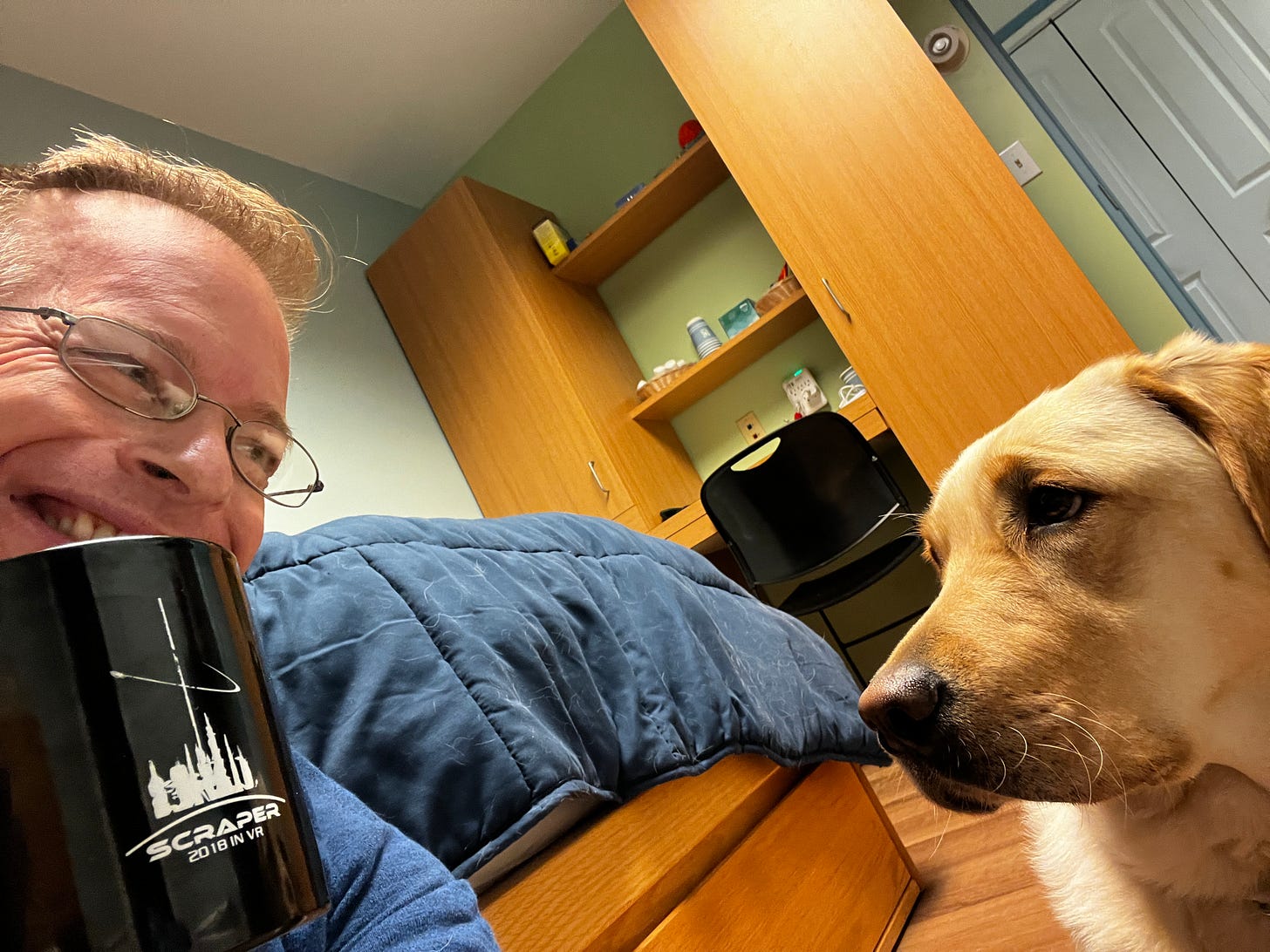About This Series
The Spirit of Recovery is a deeply personal account of my journey to receive and train with a PTSD service dog after a long wait and a longer struggle. Told in episodes, this series explores the awkward beginnings, emotional reckonings, and unexpected grace found in the process of learning to receive help. It’s about healing—not as a breakthrough, but as a quiet, daily decision to keep showing up.
A New Day Begins
Yesterday had been a full-throttle immersion—an emotional rollercoaster of steep learning curves, countless commands, and memory drills that left even the most seasoned among us humbled and spent. By the time the sun began to sink behind the hills, every student in the class—two-legged and four—was visibly drained. These were no ordinary dogs, after all. Each had been meticulously trained for a specific human, tailored not just to physical needs, but to emotional and neurological wounds too deep for words. One dog would alert to signs of a panic attack. Another could interrupt a nightmare. Another would alert a hearing impaired person when someone used their name.
The instructors had warned us: the first night might be rough. The dogs were used to training under controlled conditions—training for short periods of time, sleeping in kennels, never with real people in real rooms overnight. We were told not to be alarmed if they woke us up, startled by the novelty of human breath or stirred by instinct. They don’t know you yet, the trainer had said. But they want to.
After our final rest stop for the evening, Spirit and I returned to our assigned dorm room. A simple space—a single bed, neutral walls, a small desk. Nothing fancy. But it felt like a threshold. Her bed sat neatly against the far wall. Mine, across from hers. As I moved about the room, going through my nightly rituals, I could feel her gaze tracking me—not tense, just curious. Vigilant. She tilted her head at the buzz of my electric toothbrush, her expressive brown eyebrows raised in a question she didn’t know how to ask.
We sat together on the floor for a while. I spoke softly, letting my words come out in a natural cadence, my voice low and steady. I wasn’t saying anything important, just the kind of gentle small talk you might share with an old friend during a quiet evening. I wanted her to begin associating the sound of my voice with calmness and safety. I wanted her to know she was home.
When it was time to settle in, she padded over to her bed and circled three times before lying down, sighing the way only dogs can—something between contentment and resignation. I climbed into my own bed and switched on the lamp. I tried to lose myself in a book, but I kept feeling her eyes on me. When I looked up, there she was, head on her paws, staring at me with an unblinking stillness that felt less like observation and more like devotion. I turned a page. She didn’t flinch. It was as if she thought I might need help with it—or maybe she was simply memorizing the shape of me, the rhythm of this new life.
Even when I looked away, I could feel her eyes holding me. Not demanding. Not expectant. Just there. Present.
It was the kind of gaze I hadn’t felt in a long time.
Eventually, I turned off the light. The room fell into darkness, but she didn’t move. I whispered a quiet prayer—just a sentence or two, barely formed thoughts of thanks and trembling hope—and then I closed my eyes.
That night, Spirit didn’t stir. Neither did I.
We were still strangers.
But something had begun.
The Next Morning
When I awoke, the room was quiet, still steeped in that ethereal hush that clings to the world just before dawn. Through the spiky leaves of a large holly bush outside the window, a pale blue-grey haze filtered in, the serrated edges of the leaves casting tiny star-shaped shadows against the soft monochrome sky. A chilly draft crept in through the windowpanes and whispered across my skin, stirring me gently from sleep.
Before I could swing my legs over the side of the bed, Spirit stirred. In an instant, she was upright, her posture alert but calm, ears slightly perked, eyes fixed on me with focused curiosity. It felt less like she was reacting to a sound and more like she had been waiting for the moment I would stir. Like she’d been watching me sleep and was ready now to begin our day together.
At breakfast, the room buzzed with stories from the first night. Laughter. Coffee. A few yawns. But beneath it all, a reverence was already beginning to form. One of the students shared that his dog had woken him in the early hours of the morning. Confused at first, he soon realized that his blood sugar had dropped dangerously low. The dog had sensed it—known it somehow—and had persisted in waking him until help could be found. A quiet awe settled over the room. These dogs weren’t just companions. They were lifelines.
The formal lectures were kept to a minimum today, allowing us to transition into more active, hands-on work. Most of it was outdoors, where the somber overcast skies and crisp autumn wind provided a fitting backdrop for the internal work we were all doing. While the chill in the air made us zip our jackets higher and shove our hands in our pockets, the atmosphere among our small group was anything but cold.
Every small success was met with affirmations and quiet celebration. A dog navigating a revolving door with poise. A handler learning to trust again as they walked across a busy intersection. Spirit and I practiced stairwells, elevators, and the awkward dance of getting into and out of vehicles with a four-legged partner who never broke focus. There was something deeply grounding in the simplicity of it all—each task a metaphor, in some ways, for reentering a world we had once retreated from.
And through it all, Spirit stayed close. Watching. Listening. Learning me.
We were still new to one another. But already, a language was forming—one made not of words, but of presence, attention, and trust.
Spirit and I are clearly well matched. She is as motivated and driven as I am, eager to work from sunup to sundown, always watching me intently—her big brown eyes constantly asking what she can do next. The pace of the class has been slow so far, largely due to the wide range of student ages and ability levels, as well as a 1:4 instructor-to-student ratio. Few tasks can be taught in a group setting, which means Spirit and I often have long periods of downtime while we wait for others to complete their turn.
Spirit communicates her desire to work in unmistakable ways. She noses the leash hanging by the door, sometimes picking it up and placing it in my lap. She’ll sit beside me and stare, willing me to take her for a walk or assign her an obedience task. Her drive is evident to everyone—there’s nothing more satisfying or elegant than watching her in her element: prancing proudly on the sidewalk at a close heel, leash slack, checking in with me every few seconds, her tan-colored face lit with a beatific expression.
After lunch, the trainers gave us all a much-needed hour of rest. Dogs aren’t allowed off-leash in the rooms—they must be under control at all times, either on leash or secured by a tie-down attached to the wall above their bed. I clipped Spirit in, then laid down opposite her, hands resting on my chest, eyes closed, prepared to doze.
When I opened them again a few seconds later, Spirit was still sitting on her bed, staring at me. I decided to make things easier for both of us. I moved a pillow to the foot of my bed—right next to hers—and lay down again, reaching out to pet her. She began to relax, resting her head in my hand as I scratched the front of her neck. Her eyes slowly closed. I moved the pillow to the floor and lay beside her bed. She placed her head directly next to mine, and together we dozed until it was time for our next activity.
Our bond is beginning to grow, quietly and gently, as we learn to read each other’s body language and expressions—to trust one another as we step slowly into each other’s lives.
In the late afternoon, the grey clouds parted, allowing a brief shaft of sunlight to warm our backs as we walked through the mock city streets and parks of the training facility. Spirit and I covered several miles together while waiting for our turn to practice vehicle loading and navigating cement stairwells. At first, we stopped every few hundred feet to run through tasks and reward good behavior. But after a couple of hours, we quietly let the formal training fall away. I stopped trying to perfect her performance, and she stopped trying to prove her perfection to me. We simply walked—side by side, companions in the early stages of a partnership, moving in rhythm, at ease in each other’s presence.
A First Test
After the afternoon’s activities were complete and dinner had been eaten, we faced one final challenge for the day: a focus and redirection exercise designed to test our ability to maintain our dog’s attention in the presence of distraction. This task is essential for any working service dog, whose reliability in chaotic environments—shopping malls, airports, festivals—can make the difference between safety and risk. The timing of the exercise was intentional; both dogs and handlers were worn down from a long, mentally taxing day. Fatigue would strip away pretense and reveal the strength—or fragility—of our growing bond.
One by one, each team filed into a long, narrow training room. The carpet was worn and saturated with the scents of hundreds of dogs who had passed through before us, their invisible histories stitched into the very fabric beneath our feet. Along the beige-painted walls, old black-and-white photos hung slightly askew—images of guide dogs leading their blind handlers through city streets, reminders of the sacred trust these animals have carried for generations. The lower walls bore the signs of years of training: faded scuff marks from paws, smudges from wet noses, streaks of oil from dogs who had leaned into them seeking rest, direction, or reassurance.
We lined up side by side across the room, each handler standing with their dog on the left, spaced three to four feet apart. Spirit sat at my side, alert and calm, her body still, eyes on me. Around us, the quiet anticipation was palpable, like a classroom just before the exam begins.
One by one, the trainers approached each dog and attempted to pull their attention away from their handler. They started subtly—dropping treats on the floor, clapping hands, making kissy noises, tossing squeaky toys just out of reach. If a dog broke focus, the handler had to run through a redirection sequence—using voice commands, hand signals, and the bond they were trying to build—to regain eye contact and focus. If the dog held steady, never shifting its gaze, the handler marked the moment with praise and a quiet reward.
For the first round, the trainers approached our dogs making exaggerated kissy noises and speaking in high-pitched baby talk, trying to lure their focus away. Some dogs gave quick, curious glances toward the noise, but most held firm—clearly familiar with this kind of distraction, likely having passed similar tests many times before.
In the next round, the instructors took it up a notch by calling each dog by name. This proved far more tempting. Several dogs broke focus, momentarily deceived by the sound of their own name—understandably so, since it’s often the very first word they’re conditioned to respond to. The instructors gave calm reminders to handlers on how to regain attention, and the dogs were quickly refocused.
Then came the visual lures: first colorful streamers waved through the air in wide, fluttering arcs; then chew toys; and finally, squeaky chew toys. At this point, the room was filled with the irresistible sounds and sights of playtime, and the fatigue of the day began to show. Most of the dogs failed at least one of these rounds, unable to resist the urge to engage. After hours of obedience work, who could blame them for being eager to play?
But the final two rounds were the hardest of all—both involved food. In the first, a trainer held a single piece of kibble or treat just inches from the dog’s nose. If the dog moved toward it—even slightly—it failed the round. The temptation was immense, especially for dogs trained with food as a primary motivator.
Then came the ultimate test: a cup of kibble scattered directly on the ground in front of each dog. It was a sensory overload—smell, sight, proximity—and it took everything the dogs had to remain still, eyes locked on their handler, resisting every natural impulse. Some succeeded. Many didn’t. But all were gently corrected, and none were shamed. The point wasn’t perfection. It was learning to trust, to recover, to try again.
The valiant efforts of these incredible dogs were nothing short of inspiring. Their training was clearly exceptional. The fact that ten dogs could be lined up side by side in a room—without a single one attempting to sniff another—is a feat in itself. Add to that a full eight hours of obedience drills and service tasks, and the restraint they displayed during this test was remarkable.
Still, by the end of the exercise, a clear stratification had emerged. Some dogs struggled from the start, breaking focus with nearly every distraction. Others held steady through the earlier rounds, only faltering when the food came out. Each dog showed skill and heart, and all earned admiration.
But only one dog made it through the entire sequence without a single lapse—never once breaking eye contact, never once turning her attention from her handler.
Her spirit, true to her name, is indomitable.
About the Author
ES Vorm, PhD, is a combat veteran and aviator turned scientist who found out the hard way that achievement doesn’t equal healing. After years spent in special operations, military aviation, and human-machine teaming research, he now writes about the quiet, uncertain work of recovery—what it means to receive love, reimagine identity, and find grace in unlikely places. He lives with his family, his service dog, and a growing capacity for stillness.








